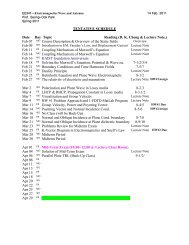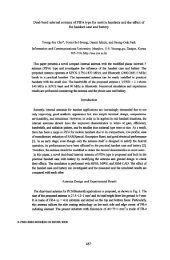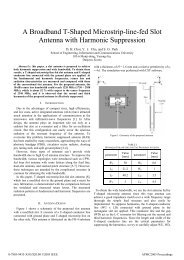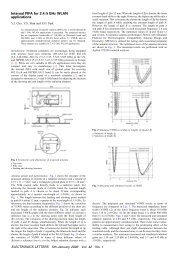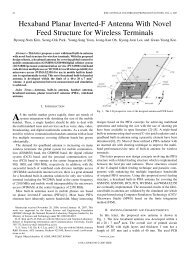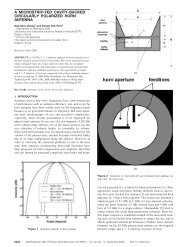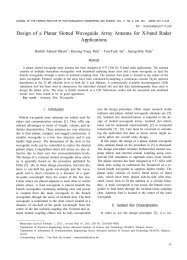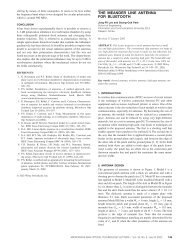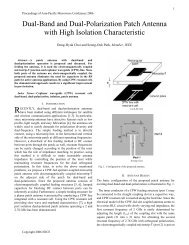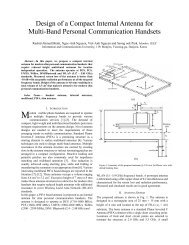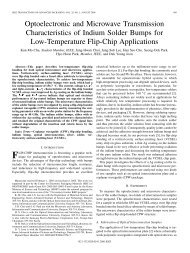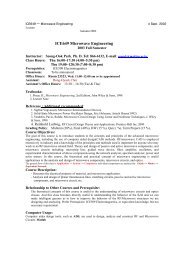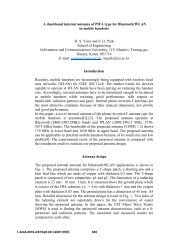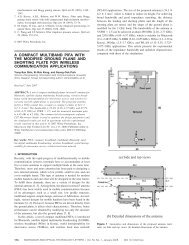Experimental Investigation of 2x2 MIMO Array Antenna for the ...
Experimental Investigation of 2x2 MIMO Array Antenna for the ...
Experimental Investigation of 2x2 MIMO Array Antenna for the ...
Create successful ePaper yourself
Turn your PDF publications into a flip-book with our unique Google optimized e-Paper software.
<strong>of</strong> each type <strong>of</strong> arrays. All antennas in each type <strong>of</strong> arrays have resonance at 2.6<br />
GHz with bandwidth about 200 MHz from 2.5 GHz to 2.7 GHz at S 11 < -10 dB.<br />
Figure 3 shows <strong>the</strong> measured 3D radiation patterns and maximum gain values at<br />
2.6 GHz. Type B has better isolation characteristic and matching condition among<br />
<strong>the</strong>m. There<strong>for</strong>e, it has better gain (4.5, 5.2 dBi) at each port equally ra<strong>the</strong>r than<br />
o<strong>the</strong>r configurations. Table 1 shows <strong>the</strong> diversity per<strong>for</strong>mance results in terms <strong>of</strong><br />
envelop correlation coefficient from 3D measured radiation patterns. All type <strong>of</strong><br />
arrays has correlation coefficient less than 0.5.<br />
Conclusion<br />
This paper investigates four types <strong>of</strong> array configurations with two chip antennas by<br />
considering mutual coupling and envelop correlation coefficient from 3D radiation<br />
patterns. According to proper spacing and polarization between antennas, diversity<br />
per<strong>for</strong>mance may be determined. The envelop correlation coefficients calculated<br />
using scattering parameters may be inadequate because <strong>the</strong> uni<strong>for</strong>m distribution <strong>of</strong><br />
sources is assumed. The radiation-pattern-based method <strong>for</strong> <strong>the</strong> envelop correlation<br />
coefficients can include real environmental factors like angular density function.<br />
Acknowledgments<br />
This work was supported by Acceleration Research(4G Handset <strong>MIMO</strong> <strong>Antenna</strong><br />
Research Center) <strong>of</strong> MOST/KOSEF(No. R17-2007-023-01000-0) and Samsung Electronics,<br />
Co. Ltd.(2007EI4513), Korea.<br />
References<br />
[1] R.G. Vaughan, and J.B. Anderson, “<strong>Antenna</strong> diversity in mobile communications,”<br />
IEEE Trans. Veh. Technol., pp. 149-172, 1987.<br />
[2] G.J. Foschini, and M.J. Gans, “On limits <strong>of</strong> wireless communication in a fading<br />
environment when using multiple antennas,” Wireless Personal communications,<br />
No. 6, pp. 311-335, 1998.<br />
[3] S.C.K. Ko, and R.D. Murch, “Compact integrated diversity antenna <strong>for</strong> wireless<br />
communications,” IEEE Trans. <strong>Antenna</strong>s Propag., pp. 954-960, 2001.<br />
[4] G.F. Pedersen, and J.B. Andersen, “Handset antennas <strong>for</strong> mobile communications,<br />
integration, diversity and per<strong>for</strong>mance,” URSI Review <strong>of</strong> Radio Science,<br />
pp. 119-139, 1996.<br />
Table 1: The Envelop Correlation Coefficient <strong>of</strong> Each <strong>Array</strong>.<br />
Type B Type C Type D Type E<br />
Correlation 0.071529 0.005669 0.028656 0.114716



